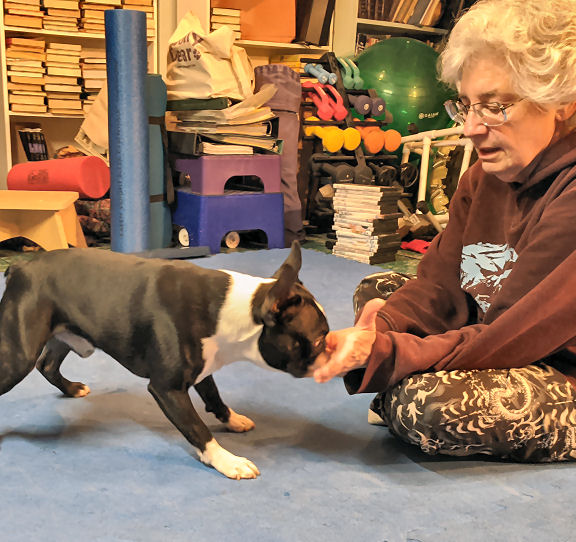Do you realize that dogs can understand motions as commands? That’s their “sign language.” At the upper tier of obedience competition, there’s even a behavior, called the “signal exercise” where all the owner can do is motion to their dog. They can’t talk, they can’t move, other than one hand/arm. It’s amazing to watch and even more fun to teach!
Part of the package

Most people don’t even realize that they’re signaling their dogs through their motions and their words. Just about every dog owner on the planet will point at the floor when teaching their dog to “down!” It doesn’t mean anything to the dog, but everyone does it. It’s our instinct at play – if we want the dog down on the floor, we point at the floor.
Eventually, if people practice and are consistent, most dogs eventually understand that we mean “down” when we point at the floor. Interestingly, the obedience signal that most people use for “down” is the arm going straight up from the shoulder, not towards the floor at all. We’d guess that’s because we want to make sure the dog can see the motion from 30 (or more) feet away in competition.
There’s nothing wrong with pairing words and motions when communicating with your dog. The point is to realize that you’re doing it. And that, if you do the same thing the same way all the time, your dog will inevitably associate the two – word and motion.
Conscious uncoupling
It’s always a bit of a shock to our beginner students when we ask them to stand up straight, not move, and tell their dogs to “Sit.” Rarely do any of the dogs get it right. Because every single person came into class absolutely convinced their dogs knew the word “Sit.” You can see people almost twitching to point at their dogs’ butts, or dangle a treat over their heads. That sign language of dogs, along with the words, combined to form “Sit!”
It’s a good idea to “uncouple” the sign language and the words. Having your dog understand either one, or both together, means that there’s no situation in which you can’t communicate with your dog. If you’re in a very loud space, or far away, your dog may not hear you, but can see. Or you may be someplace where it’s just not feasible to point at the ground to get a “Down.”
Another kitchen game
Try playing “Puppy Pushups” with your dog (we talked about “Puppy Pushups” a few weeks ago). Start by using both your “sign language” and your words. After just a couple of repetitions, try leaving out the motion. Or the words. See how your dog does. In a familiar game context, your dog will probably catch on quickly. When your dog gets it right about 80 percent of the time, increase the distance between you and your dog. Will she do it from five feet away? 10? How about across the street? With just your words? Only on the signs?
It doesn’t really matter which words, or signals, you use. Pick something you’re comfortable with, that you’ll easily remember. If you want to use the same motions that are most common in Obedience Competition, check out the exercises from the 2019 AKC Obedience Classic. (The Signal Exercise is right after the heeling.) Most “handlers” use the same signals and it will give you a chance to see them and their amazing dogs in action.






